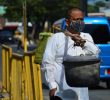And as the faithful celebrates Christ’s resurrection Sunday, Callao who heads the IFI’s Davao Diocese, challenges everyone to engage in the mission of Shalom.
By JOHN RIZLE L. SALIGUMBA
Davao Today
DAVAO CITY, Philippines — A bishop of a Catholic Church organization which owed its root to the Philippine revolution says the celebration of the Holy Week should be a challenge to transform the society and not just to re-enact the passion, death and resurrection of Jesus Christ.
This is because “Christ’s mission did not end in his three-year ministry,” said Bishop Delfin Callao Jr. of Davao City’s Iglesia Filipina Independiente (IFI or the Philippine Independent Church).
“That is actually the challenge being presented by the re-enactment. Christ became man to experience the life of the people whom he had served. He was killed but he defeated death and resurrected to fulfill a mission,” he told davaotoday.com.
Sticking to his belief, Callao said that “Jesus did not set himself to die.” Rather he was killed. “It was not part of the master plan of God.”
He said that what brought Jesus to the Cross is the “persistent disobedience of the people and the rejection in the implementation of his plan, the Shalom.”
Shalom, he said, is “not the absence of war.” “It is living in God’s Kingdom who rules with peace, justice and equality. It is living a dignified life,” he added.
The reason why Jesus Christ made himself human, he said, was not only to save souls but to totally transform humans.
But the Bishop observed that in these times, only a few are involved in the achievement of Shalom. Quoting a verse from the Bible, he said, “The harvest is many but the workers are few.”
For Callao, Shalom means the faithful helping farmers fight for lands to till, for the workers’ struggle for decent wages, and for the youths’ right to education, among others.
He added that women must be treated with equality and minorities should determine their own faith. Countries around the world, he added, should be liberated from the domination of other countries.
And as the faithful celebrates Christ’s resurrection Sunday, Callao who heads the IFI’s Davao Diocese, challenges everyone to engage in the mission of Shalom.
Back to its roots
Callao explained that from a “Universal Church” founded by Christ, there had been splits of the Catholic faith. As far as he can remember, he said, the Orthodox split to two groups. “Later, there was also a split of one group called the Anglicans where the IFI had its roots.”
But despite this, the practice of the “Catholic tradition” and “liturgical calendar” is largely the same. For example, the Lent starts during Ash Wednesday while the Holy Weeks starts at the triumphal entry (Palm Sunday).
The IFI, according to historian Gregorio Zaide, is the “the only tangible result of the Philippine revolution.”
It’s popularly known as the Aglipayan Church after Fr. Gregorio Aglipay who “played an important role in the revolutionary war to overthrow Spanish rule and in the struggle for the Filipinization of the Church,” according to its website (ifi.ph).
“Filipinization” means the “organizational foundation of the Filipino Church” which Aglipay helped lay down in a gathering of Filipino priests in a special meeting on October 1898.
Aglipay was then serving as the Military Vicar of the Revolutionary Government under the Kataas-taasang, Kagalang-galangang Katipunan ng mga Anak ng Bayan founded by port laborer Andres Bonifacio.
During the Spanish rule, the Filipino clergy rallied against “racial discrimination” and “domination of Spanish friars” within the Roman Church in the 19th century.
This, “consequently, transformed into a nationalist crusade for the absolute Filipinization of the Church in the twilight years of the 20th century.”
However, the “formal institution” or the separation of Philippine Churches from Rome was however prevented “by the intrusion of the United States of America in the course of the revolutionary war against Spain.”
In 1901, Fr. Aglipay returned to Manila in a negotiated surrender after fighting in the Ilocos region “against US aggression.” He immediately resumed the crusade for the Filipinization of the Church. While keeping an eye on how “the US colonial set up might influence reformation within the Roman Church, he explored the potential of cooperating with Protestant Churches which had his efforts irreverently refused.”
On August 3, 1902, in a public protest spearheaded by the Union Obrera Democratica, the first labor confederation in the country, the IFI was publicly proclaimed.
Isabelo de los Reyes, Sr., president of the labor confederation, nominated Fr. Aglipay as Obispo Maximo (Supreme Bishop) who eventually joined the IFI and headed the signatories of the Temporary Constitution on October 1902.
Even if during this period “the institutional and missionary churches were cooperating with the colonial government and patriotic Filipinos continue to sustain the struggle for national democracy in the backdrop of US colonial set up.”
In a nutshell, the IFI “was formed in the beginning of the twentieth century as part of the broad nationalist struggle against Spanish colonialism and American imperialism.” (John Rizle L. Saligumba/davaotoday.com)










